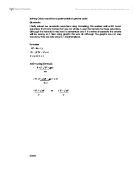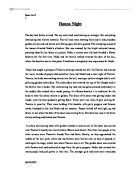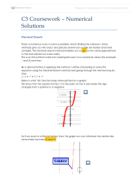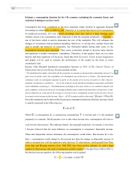C3 Mei - Numerical Methods to solve equations
C3 Coursework In this coursework, I will use numerical methods to solve the following equation, as I cannot solve it algebraically. I can only obtain an approximation of the solution as it is impossible or hard to find the exact value of the function. Decimal Search The graph below is the function I will use decimal search in order to find an approximation of one of the roots. The table below shows decimal search. Each boundary is tested for sign change which indicates that a root exists between them. The x where the sign change occurs in now the new boundaries and tested for sign change again. This method is repeated until an approximation of the root is found to a suitable number of decimal places. x f(x) 0 2 0.1 .9501 0.2 .8016 0.3 .5581 0.4 .2256 0.5 0.8125 0.6 0.3296 0.7 -0.2099 0.8 -0.7904 0.9 -1.3939 -2 x f(x) 0.66 0.011747 0.661 0.006295 0.662 0.000838 0.663 -0.00462 0.664 -0.01009 0.665 -0.01556 0.666 -0.02104 0.667 -0.02652 0.668 -0.032 0.669 -0.03749 0.67 -0.04299 x f(x) 0.662 0.000838 0.6621 0.000292 0.6622 -0.00025 0.6623 -0.0008 0.6624 -0.00135 0.6625 -0.00189 0.6626 -0.00244 0.6627 -0.00299 0.6628 -0.00353 0.6629 -0.00408 0.663 -0.00462 x f(x) 0.6 0.3296 0.61 0.277958 0.62 0.225763 0.63 0.17303 0.64 0.119772 0.65 0.066006 0.66 0.011747 0.67 -0.04299 0.68 -0.09819
Solving Cubic equations or polynomials of greater order
Solving Cubic equations or polynomials of greater order Quadratic I firstly solved our quadratic equations using factorising, this worked well until I found equations that have factors that are not whole. I used the formula for these equations, although the formula is very hard to remember and if it's written incorrectly the answer will be wrong, so I tried using graphs this was ok although the graphs are not very accurate, they are only around 1 decimal place. Factorise X² - 6x + 5 (x - 5) (x - 1) = 0 x = 5 or x = 1 Solve using formula - b +/- V b² - 4ac 2a + 6 +/- V 36 - 4 x 1 x -5 2 x 1 + 6 + V 56 or + 6 - V 56 2 2 Cubic Here I first tried solving the equations by factorising, as with the quadratic equations this worked well until I came across equations with factors including decimal places. For these I tried as before to use the formula but I firstly need to find one of the factors, and if all factors include decimal places this can be difficult. So I lastly tried to solve the equation using graphs, this was extremely hard as the cubic graph needs more detail and I found that the graph as before was only correct to one decimal place. This is not accurate enough for a cubic graph. Now, I have decided to go and look for other ways in which it would be possible to find all the factors of the equations which is accurate. I have now found a new
Design, make and test a Sundial.
Sundial Coursework Statement of Task: To design, make and test a Sundial. Introduction: The sundial is the oldest know device for measuring time. The first confirmed uses of it where by the Babylonians in around 2000BC. However it is safe to say that shadows have been used as a rough measure of time ever since primitive man discovered that as the day progresses the shadows of trees and rocks get shorter and then longer again. The sundials used by the Babylonians were hollow half spheres, set with edges flat and with a small bead at the centre. As the day wore on the shadow of the bead followed a circular arc, which is divided into 12 "temporary hours" (they changed through the seasons). A modern sundial consists of a plane (dial face) and the gnomon (style). The dial face is divided into hours and the gnomon is the flat piece of metal, or stick in the dials centre, it points towards the North Pole (in the northern hemisphere) or South Pole (in the southern hemisphere). The gnomon must tilt at the angle of the latitude at the location. Although a sundial seems like a simple device for measuring time, it is not. One cannot simply look at the shadow and find the time. Firstly the sundial will show local time, not GMT. Secondly we must allow for the 'equation of time.' Because the Earth's orbit is not circular, its velocity changes at the perihelion. To allow for this
Numerical solution of equations
Pure Mathematic 2 Coursework Numerical solution of equations By Michael Pang I am going to show 3 of the numerical methods for solving the equation which cannot be solved algebraically. They are interval estimation, fixed point estimation and Newton-Raphson method. Those of these numerical methods are used when algebraic ones are not available. When you found any equations which cannot be solved algebraically, probably you will draw the graph and see where the roots are. However, the other problem is found that you cannot get all roots accuracy. Actually, the numerical methods cannot find the exactly root but the answers are more accuracy than sketching the graphs. Therefore, we usually provide the answer to 5 or 6 decimal places depending on what the questioner needs. Finally, we check the answer by setting the lower bound and upper bound to see whether it has sign change or not. Even if the three numerical can solve the equation non-algebraically, they have its advantages and disadvantages. And now I am going to show how these methods works and their problems by using the equation F(x) = x³-9x+3. Interval estimation Assume that the roots of the equation F(x) = x³-9x+3, and I am looking for the roots which F(x) = 0. The roots of the equation are the values of x which the graph of y = x³-9x+3 crosses the x axis. By using the computer, I recognise that there are 3
Mathematics portfolio - Translations.
Man Ju Y12D Mathematics - portfolio Translations . 2. is the effect of translation vector of . It moves up 2 units. is the effect of translation vector of . It moves up 4 units. is the effect of translation vector of . It moves down 3 units. 3. + 3 is the effect of translation vector of . It moves up 3 units. -1 is the effect of translation vector of . It moves down 1 unit. 4. Curves move either up or down vertically. The units they move is according to the number after x2 in the equation . If the number is positive, the curve will be pulled upwards. If the number is negative, the curve will be pulled downwards. 5. f(x) = sinx -2 is the effect of translation vector of f(x) = sinx. It moves down 2 units. This has the same effect with the previous examples. The unit it moves is according to the number after sinx in the equation f(x) = sinx c. If the number is positive, the curve will be pulled upwards. If the number is negative, the curve will be pulled downwards. Therefore the generalization extends to any function f(x). 6. 7. is the effect of translation vector of . It moves right 2 units. is the effect of translation vector of . It moves right 3 units. is the effect of translation vector of . It moves left 1 unit. is the
OCR MEI C3 Coursework - Numerical Methods
C3 Coursework Change of sign (decimal search) Finding a root of an equation with graphical illustration f(x)=x3-7x2+2x+1 This is graph of y=x3-7x2+2x+1 The graph shows that roots of f(x)=0 exist in the intervals [-1,0]; [0,1]; [6,7] We shall test for a root in the interval [6,7] x f(x) 6.0 -23 6.1 -20.289 6.2 -17.352 6.3 -14.183 6.4 -10.776 6.5 -7.125 6.6 -3.224 6.7 0.933 Change of sign indicates root exists in interval [6.6,6.7] This means that x=6.65±0.05 x=7 (0d.p.) x f(x) 6.60 -3.224 6.61 -2.81992 6.62 -2.41327 6.63 -2.00405 6.64 -1.59226 6.65 -1.17787 6.66 -0.7609 6.67 -0.34134 6.68 0.080832 Change of sign indicates root in interval [6.67,6.68] This means that x=6.675±0.005 x=6.7 (1d.p.) x f(x) 6.670 -0.34134 6.671 -0.29924 6.672 -0.25711 6.673 -0.21496 6.674 -0.17278 6.675 -0.13058 6.676 -0.08835 6.677 -0.04609 6.678 -0.00381 6.679 0.038498 Change of sign indicates root in interval [6.678,6.679] This means that x=6.6785±0.0005 x=6.68 (2d.p.) X f(x) 6.6780 -0.00381 6.6781 0.000419 Change of sign indicates root in interval [6.6780,6.6781] This means that x=6.67805±0.00005 x = 6.678 (3d.p.) Failure of the decimal search Two of the roots of f(x)=0 where f(x)=5x3-20x2+2x-0.05 could not be found with this method. This is because they are so close together that there is no sign change
There are three snails; slippery, slimy and slidey. They enter a ten-metre race for food. Each snail runs according to the following rules. Slippery : d= 4.4 + 0.55t Slimy : d= 0.3t(t-7) Slidey : d= 0.3t(t-3.4)(t-9)
(Speedy Snails) INTRODUCTION Mathematics can be used to solve the problem happened in our life such as finding distance or time. Now, we've got a problem here. We want to know following questions below. Let us solve the problem by using mathematical method. There are three snails; slippery, slimy and slidey. They enter a ten-metre race for food. Each snail runs according to the following rules. Slippery : d= 4.4 + 0.55t Slimy : d= 0.3t(t-7) Slidey : d= 0.3t(t-3.4)(t-9) The snails race from a designated starting point toward a designated finish line. The distance, d, is measured in metres, and the time, t, is measured in minutes. QUESTIONS . Find the distance of each snail from the start after: (An appropriate window and graph) There are two ways to solve the question 1. Firstly, we can substitute the time into each formula. (a) 0 minutes Slippery : d = 4.4 + 0.55t = 4.4 + 0.55(0) = 4.4 + 0 = 4.4(m) Slimy : d = 0.3t(t-7) = 0.3(0)(0-7) = 0(-7) = 0(m) Slidey : d = 0.3t(t-3.4)(t-9) = 0.3(0)(0-3.4)(0-9) = 0(-3.4)(-9) = 0(m) Name of snails Slippery Slimy Slidey Distance (m) 4.4 0 0 (A distance of each snail when the time is 0 min.) (b) 2minutes Slippery : d = 4.4 + 0.55t = 4.4 + 0.55(2) = 4.4 + 1.1 = 5.5(m) Slimy : d = 0.3t(t-7) = 0.3(2)(2-7) = 0.3(-10) = -3(m) (This means Slimy is going backwards) Slidey : d =
Investigate the three different numerical methods used to solve equations.
Solving Equations by Numerical Methods Introduction In this coursework I am going to investigate the three different numerical methods used to solve equations. These include the change of sign method, Newton Raphson method and the Rearranging method. To carry out the investigation I will explain how each method works, using an example of a working equation in each case. I will also show when each of the methods will not work with other equations. I will then compare all three of the methods. Change of sign method Decimal search and Interval bisection are both ways of finding an interval where there is a change of sign. The change of sign can be found on a graph when the line crosses the x-axis. Wherever there is a change of sign there will be a root. These two methods find the interval where the root lies. Decimal Search To find the roots using decimal search, the y-values must be found, using the values of X from 0.1, 0.2, 0.3, all the way up to 1. When a change of sign occurs, this means there is a root lying here. Once the root interval to 1 decimal place has been found, it must then be found to 2 and 3 decimal places and so on to the required number of places. Y=x3-5x+1 can be solved using decimal search. The table shows that the routes can be found. X Y X Y X Y 0 2 -1 -2 3 0.1 0.501 2.1 -0.239 -2.1 2.239 0.2 0.008 2.2 0.648 -2.2 .352 0.3
In this coursework I will be looking at equations that cannot be solved algebraically
Core 3 Coursework In this coursework I will be looking at equations that cannot be solved algebraically. Instead I will look at three numerical methods for solving them: the change of sign method; the Newton-Rhapson method; and the rearranging method. Change of Sign Method - Decimal Search I am going to solve the equation using the decimal search (change of sign) method. I will find the y-values and look for the point at which there is a change of sign, because if there is a change from positive y to negative y then the curve must pass through the x-axis so there will be a root. Here is a graph of the function There is only one root; it lies between the integer bounds [-1,0] I have calculated the corresponding y-value for each x-value within this range, 1 decimal place apart. x y -1.0 -5 -0.9 -3.635 -0.8 -2.52 -0.7 -1.625 -0.6 -0.92 -0.5 -0.375 -0.4 0.04 -0.3 0.355 -0.2 0.6 -0.1 0.805 x y -0.50 -0.375 -0.49 -0.3281 -0.48 -0.2826 -0.47 -0.2382 -0.46 -0.1951 -0.45 -0.1531 -0.44 -0.1123 -0.43 -0.07263 -0.42 -0.03404 -0.41 0.003495 -0.40 0.04 Again the change of sign is highlighted; the root must lie between [-0.42,-0.41], so I will investigate these values. x y -0.420 -0.03404 -0.419 -0.03024 -0.418 -0.02645 -0.417 -0.02267 -0.416 -0.0189 -0.415 -0.01514 -0.414 -0.01139 -0.413 -0.007656 -0.412 -0.003929
Henna Night
Henna Night The day had finally arrived. The icy cold wind was blowing so strongly, that everything obstructing was thrown instantly. The tall trees were swaying from side to side, bundles golden, brown and red leaves were falling upon the bare ground. The crumpling sound of the leaves attracted Nadia's attention. She was amazed by the bright coloured leaves, planning ideas for her future art project. Nadia, a sixteen year old had attended a Henna function for the first time. Nadia and her family walked towards the door of the hall, where the function was to take place. It had been a completely new experience for Nadia. Nadia had caught a glimpse of Yasmin walking towards the hall. As Yasmin had entered the room, crowds of people obstructed her view, but Nadia had a clear sight of Yasmin. Yasmin, the bride was walking slowly into the hall, wearing a yellow lehngha (skirt) with glittering golden embroidery. The embroidery was towards the top of the lehngha and at the bottom like a border. Her shimmering top had red and gold coloured embroidery in the middle. She looked like a model posing. At a Henna function it is traditional for the bride to wear the colour yellow or golden. The drole of the drum was getting louder and louder, with the beat gradually getting faster. There were two lines of girls waiting for Yasmin to pass by. They were holding little baskets with party















